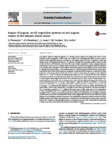Use este identificador para citar ou linkar para este item:
http://biblioteca.incaper.es.gov.br/digital/handle/item/740| Título: | Impact of organic no-till vegetables systems on soil organic matter in the Atlantic Forest biome. |
| Autor(es): | THOMAZINI, A.  MENDONÇA, E. S.   SOUZA, J. L. de.   CARDOSO, I. M.   GARBIN, M. L.   Jacimar Luis de Souza, Incaper.   |
| Palavras-chave: | Green manure Labile and stable fractions Soil health Soil C balance |
| Data do documento: | 5-Jan-2015 |
| Editor: | Scientia Horticulturae, Vol. 182, p. 145-155, 23 january 2015. |
| Descrição: | Soil organic matter is widely recognized as a strategy used to improve soil quality and reduce carbon emissions to the atmosphere. A field study was carried out to investigate the effects of cover crops in organic no-till vegetables systems on changes in soil organic matter and CO2single bondC emissions, in dry and rainy seasons. We hypothesized that CO2single bondC emissions are higher in conventional till as compared with no-till, and that no-till increases soil C sink. The crop rotation comprised a 3-year cropping sequence involving two crops per year?cabbage (Brassica oleracea L.) in winter and eggplant (Solanum melongena L.) in summer time. Treatments were no-till on dead mulch of grass (Avena strigosa Schreb. and Zea mays L.), leguminous (Lupinus albus L. and Crotalaria juncea L.), intercrop (grass and leguminous) and conventional till (no dead mulch) with rotary hoe arranged in a randomized block design on a clayey Oxisol (Typic Haplustox) at Domingos Martins-ES, Brazil. On 2012 and 2013, disturbed soil samples at three different layers (0?5, 5?15 and 15?30 cm) and undisturbed samples at 0?10, 10?20 and 20?30 cm, for chemical and organic matter characterization were taken. CO2single bondC emissions and soil temperature were measured in situ on March, May, August and October 2012 and February 2013 (after 3 years of experiment). Conventional till site showed the lowest microporosity values and the highest macroporosity, followed by lower soil bulk density at 0?10 cm layer. Total organic C ranged from 34.94 to 50.48 g kg?1 in intercrop and 27.11 to 43.74 g kg?1 in conventional till. Total N ranged from 2.81 to 5.34 g kg?1 in grass and 2.54 to 4.51 g kg?1 in conventional till. Highest C stock was recorded in intercrop. Conventional till showed lower labile C values while recalcitrant C was higher in the intercrop treatment. The annual average of CO2single bondC emissions (?mol CO2 m?2 s?1) followed the order: grass (15.89) > intercrop (13.77) > leguminous (13.09) > conventional till (11.20). Highest annual average of soil temperature was recorded in conventional till (23.95 °C). Lowest annual mean of soil water content, microbial biomass C, and highest metabolic quotient were recorded in conventional till. These results suggest that the use of cover crops and organic compost in pre-planting promote C increments. The contribution of organic residues increases the water holding capacity and reduces soil temperature. No-till reduces soil disturbance and promotes a positive balance of C. Organic no-till vegetable systems is a strategy to increase soil C and should be encouraged in order to increase soil quality in the Atlantic Forest Biome in Brazil. |
| URI: | http://biblioteca.incaper.es.gov.br/digital/handle/item/740 |
| Aparece nas coleções: | Memória Técnica do Incaper  |
Arquivos associados a este item:
| Arquivo | Descrição | Tamanho | Formato | |
|---|---|---|---|---|
| Scientia-Horticulturae-Andre-Thomazini.pdf | 1,89 MB | Adobe PDF |  Visualizar/Abrir |
Os itens no repositório estão protegidos por copyright, com todos os direitos reservados, salvo quando é indicado o contrário.
